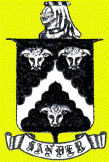I was born 5 December 1914 in Oakland, California. My father died of tuberculosis a year later. My mother Margaret Eleanor Sander (nacutee Davies) reared me with the help of her brother John until his death in 1932. I attended five public schools in the city of Oakland, graduating in June 1932 from Oakland High School, then on Park Boulevard. While there I entered the Junior ROTC, becoming officer cadet commanding the unit in my Senior year. Click on the link here to get an idea of my aspect as child and
youth. Other links on this and the following pages also bring up photos.
That same year I entered the University of California (Berkeley) and graduated in 1936 with a BA in paleontology and a commission as Second Lieutenant, Coast Artillery Corps, in the Army of the United States. In May 1938 I was granted an MA for a thesis titled,"A Monograph on the Lamellibranch Genus Mulinia," but I had quarreled with one of the professors chosen to judge my competence for the Ph D. So, on 1 February of that year I had gone to work in Los Angeles for the Standard Oil Company of California, while writing the last pages of the Master's thesis in a hotel room.
In late November of 1938 I was sent to Saudi Arabia. The trip by train and boat took nearly a month, but was much more interesting and more truly an "experience" than the hundreds of journeys by air that I endured later. Pictures I took on the trip are shown in the link along with a snap of a greeting at the pier like the one given the group when we arrived.. My work became my life, for in a land little known geologically I was given responsibilities from the start that many geologists of much greater experience would have coveted. After an initial period when I worked alone with a driller and one 'core-hole' rig to demonstrate the existence of the structure now the Abqaiq field, I headed the group assigned to map the subsurface contours of a major anticlinal fold. It is now the largest oil field in the world, Ghawar.
On 8 July 1939 seven months after my arrival I was peering into a microscope at rocks from the mile-deep producing level of the discovery well, Dammam No.7, when a small boy in the universal dirty white nightshirt ran into the oven that was the tin-roofed shack laboratory. He pulled at my arm, exclaiming in his high-pitched voice,"Shoof, Sahib!" (Look, Sir!). I followed him into the unpaved street and saw the steel derrick of the rig toppling into the flames. I ran for my Leica, drove to the site, and took this snap. Ten days of frantic work put the fire out. Several men lost their lives in the initial burst of flaming gas That same year I spent the Christmas holidays as caretaker of a field camp near Hofuf. I took six of these eight shots then.
In Arabia, the war caused food and equipment shortages and inconveniences in travel and communication. Work went on apace, nevertheless. Minor damage to the oil camp, Dhahran, by a stray Italian bomber hastened management 's decision to slow exploration until war's end. (Late in 1944 the United States at last recognized the value of the discoveries and all-out exploration and exploitation efforts
resumed, but were hampered by shortages.)
As a consequence of that decision, I returned to the United States in June 1941 on leave. On the morning of 7 December, en route to Arabia again, I boarded in San Francisco the same ship that had brought me to New York, the President Monroe. Just past the Golden Gate bridge it turned around and returned to the dock.Five months later I was on active duty at Camp Hahn near Riverside, a lieutenant in the 413th AA Battalion (90 mm. Sep). In December of 1942 the army reread my file and sent me to Washington by priority air because I can read and write French. Operations after the landing in North Africa required liaison officers who were familiar with that language. After a month in censorship school, I flew in a spanking new DC-7 with a planeload of French-speaking officers via Georgetown, (then British Guiana), Natal, (Brazil) Ascension Island, (British colony, a dot in the mid Atlantic) to Accra (now in Ghana). From there to Algiers in a night flight we lay on mail sacks in the belly of a B-26 light bomber.
Top
Page 2
Page 3
Page 4
Page 5
Page 6

